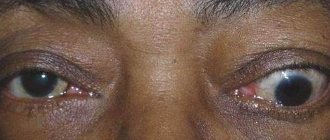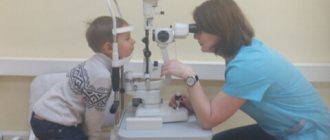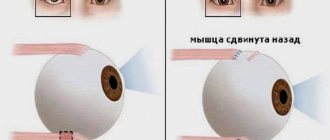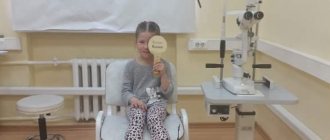Strabismus is a common ophthalmic problem affecting both children and adults. With this disease, the correct position of the eyeballs is disrupted when a person tries to look straight. If both eyes “squint” in turn, this type of pathology is called alternating strabismus. We'll talk about it in this article.
In this article
- Concept of strabismus
- What vision problems can strabismus cause?
- Alternating strabismus as one of the forms of the disease
- Alternating concomitant strabismus - what are its features?
- Alternating strabismus: where does the gaze deviate?
- How is alternating strabismus diagnosed in adults and children?
- Alternating strabismus in children: how is it treated?
- What eye exercises can be performed for alternating strabismus?
- How is surgery performed and when should it not be performed?
- Prevention of alternating strabismus
- Conclusion
Concept of strabismus
Strabismus (the medical term for strabismus) is a problem that is visible even to the naked eye. In a person suffering from such a defect, the position of the eyes differs from the usual. When a person tries to look straight, one or both pupils are not directed forward, but are more or less deviated to the side.
Many believe that strabismus in any form is purely a cosmetic problem, as it negatively affects the perception of a person’s appearance. In fact, strabismus is primarily a medical problem that can often lead to serious visual impairment.
Examination for strabismus
It is noteworthy that most infants squint a little in the first six months of life. This is due to the peculiarities of the development of the visual system during this period. From time to time, the baby's eyes bunch up, reminiscent of the symptoms of convergent strabismus. There is no need to panic, but you still need to show your baby to an ophthalmologist.
When the child reaches six months, he should stop squinting his eyes. If symptoms continue, parents should address the issue and have the baby checked.
Examination methods for strabismus:
- Interviewing parents if the patient is a child. The doctor must find out the suspected cause and period of occurrence of strabismus, the features of its development and concomitant eye diseases.
- Determination of visual acuity (visometry). It is important to evaluate the vision of each eye separately and both at once, as well as visual capabilities with and without correction.
- Determination of the nature of strabismus.
- Determination of the type of defect by direction.
- Measuring the amount of deviation. For these purposes, the Hirshberg method is used: the patient looks at the mirror of a special device, and the ophthalmologist studies the light reflexes of the cornea.
- Study of binocular, simultaneous and monocular vision.
- Study of eye mobility. The disadvantage of this method is that it can only detect severe limitations in mobility.
- Determination of fusion ability using a synoptophore.
- Study of eye refraction using a skiascope.
- Analysis of visual fixation (if vision deteriorates). The study can be carried out using a vizoscope and an ophthalmoscope.
- Checking the optical environment (biomicroscopy, campimetry, ophthalmochromoscopy, photostress test). Sometimes strabismus develops due to anatomical changes in the eyeball.
- Electrophysiological studies.
- Determination of retinal visual acuity.
A child with strabismus may need additional consultation with a pediatrician, otolaryngologist, neurologist and other specialists.
What vision problems can strabismus cause?
Normally, when a person examines a certain object, its image falls into the central zone of the right and left eyes, after which the brain combines the two images into one three-dimensional one. Such vision is usually called binocular; it allows us to perceive surrounding objects in three-dimensional format, see depth, correctly estimate the size of objects, the distances between them.
In most forms of strabismus, binocularity is impaired because the brain is unable to fuse together the resulting images. To protect a person from double vision, he “turns off” the image transmitted by the squinting eye. This leads to monocular vision, in which objects appear flatter and the perception of their normal sizes is disrupted.
If strabismus is not treated, sooner or later one eye practically ceases to participate in the visual process, developing a condition known as amblyopia. To preserve your vision, at the slightest suspicion of developing strabismus, you must consult a doctor and undergo a full diagnostic examination.
Causes of strabismus
The exact causes of strabismus are unknown. Pathology can be congenital or acquired. Congenital strabismus, as a rule, manifests itself already in the first six months of life. Since it is not possible to accurately establish a diagnosis during this period, it is recommended to monitor the patient.
Acquired strabismus occurs early, that is, it occurs in the first year of a child’s life. However, most often the causes of strabismus are diagnosed in children older than 2-3 years. It is generally accepted that heredity plays an important role in this process. Congenital strabismus is the result of intrauterine infections. A child may be born with a defect if the mother suffered severe intoxication during pregnancy.
Other causes of strabismus:
- “childhood” diseases (scarlet fever, measles, colds);
- underdevelopment of the oculomotor muscles;
- pathologies of the muscles of the eyeball;
- refractive errors (astigmatism, farsightedness, myopia).
Convergent strabismus can be an independent disease or a sign of another pathology. Eye defects occur with the development of tumors in the brain, Down syndrome, cerebral palsy, microcephaly, hydrocephalus, and congenital cataracts. Strabismus also appears with neuralgia and trauma, including psychological.
Alternating strabismus as one of the forms of the disease
There are many types of strabismus, depending on the cause of the pathology, the nature of its manifestation, the direction of displacement of the eye from the central axis and other factors.
Due to its occurrence, ophthalmologists divide strabismus into two main groups:
- paralytic strabismus;
- concomitant strabismus.
The first type can develop at any age and is most often caused by damage to the nerve fibers that connect the eye muscles with the central nervous system (for example, as a result of injury). With the paralytic type of pathology, the ability of the eyeball to move is severely and sometimes completely limited; no binocular vision; A ghosting effect often occurs. A characteristic feature of paralytic strabismus, in addition to limited mobility of the visual organ, is a large difference between the angles of deviation of the two eyes.
Concomitant strabismus often develops in young children. Possible causes include decreased vision in one eye, uncorrected refractive errors, diseases of the retina, optic nerve, and neurological pathologies. Unlike the paralytic form of strabismus, concomitant strabismus is accompanied by normal mobility of both eyeballs, approximately the same angle of deviation of the healthy and squinting organ, and the absence of double vision. In this case, a decrease in visual acuity, disturbances in binocular vision, the appearance of functional scotomas in the visual field, and pathologies of refraction may be observed.
Based on the involvement of the visual organs, the concomitant form of the disease is divided into monolateral and alternating. In the first case, only one eye is squinting, in the second, both are squinting. The most common occurrence in children is alternating concomitant strabismus. Let's tell you more about it.
Will it be possible to cure the child?
In most cases, yes, especially if the pathology is detected at an early stage. Remember that convergent squint will never go away on its own! If you ignore the disease, it will result in serious complications, such as amblyopia and developmental delay.
Even if you are lucky and there are no serious consequences, strabismus is a cosmetic defect that causes discomfort in children. As a result, the baby grows withdrawn and uncommunicative. Remember that it is much easier to get rid of an anomaly at an early age. Therapy must be carried out until the age of twenty-five, when the visual system is fully formed.
You will learn how to treat strabismus in children from the video
Alternating concomitant strabismus - what are its features?
Alternating strabismus is a paired lesion of the organs of vision, in which symptoms appear in one or the other eye. Due to this feature, the pathology is also called intermittent strabismus, and it is a common form of concomitant strabismus.
The following set of symptoms often indicates alternating strabismus:
- deviation of the pupil of a squinting eye from the central axis;
- alternate fixation of the right and left eyes;
- decreased visual acuity in one eye (which squints more often) or in both;
- sometimes headache and dizziness.
Concomitant alternating strabismus is considered relatively favorable for the patient compared to other forms of the disease. With this type of strabismus, diplopia rarely develops, eye mobility is preserved, and in some cases amblyopia does not even develop. In addition, with proper and early treatment, there is a high chance of restoring binocular vision or at least stopping the development of pathology and improving the patient’s quality of life.
Features of the course of the disease
The pathology often affects children under three years of age. Deviation of the pupil from the central axis results in the child receiving a blurry picture. It is impossible to predict at what point the muscles will weaken and stop performing their functions, so it is difficult to prevent symptoms.
If a change in the axis of the eyes is observed regularly, then there is a large load on the brain. It cannot process the information it receives quickly and efficiently, and as a result, the activity of the damaged eye is suppressed. However, this type of strabismus is considered the least dangerous to health. In this case, split images are almost never observed, since both eyes are in an identical state. The eyeballs also remain mobile. Amblyopia is diagnosed quite rarely.
| Alternating strabismus in a child is much easier to cure than in an adult. Special exercises and wearing corrective optics will help get rid of the anomaly. |
Even if it is not possible to restore eye health 100%, you can prevent the progression of the anomaly and make the life of a person suffering from strabismus as comfortable as possible. Return to contents
Alternating strabismus: where does the gaze deviate?
Alternating strabismus can be convergent or divergent, depending on which direction the pupil of the squinting organ is directed.
Convergent alternating strabismus suggests that the pupil of the affected organ shifts from the central axis to the bridge of the nose. In this case, the external muscles responsible for eye movements are weakened and cannot provide enough tension to “align” the position of the organ.
Alternating strabismus is accompanied, on the contrary, by weakness of the internal muscles and excessive tension on the part of the external ones. As a result, the pupil of the affected organ is directed towards the temporal zone. According to doctors, convergent strabismus is more common.
Convergent alternating strabismus often occurs against the background of farsightedness, while divergent strabismus often occurs against the background of myopia. In addition to the most common forms, convergent and divergent strabismus, there is also vertical and combined strabismus.
With a vertical pupil, the pupil does not shift in the horizontal plane, but vertically: it deviates downwards or upwards. With a combined form of pathology, the eyes can squint in different directions - both horizontally and vertically. Unlike convergent and divergent strabismus, these species are rare, but nonetheless worth knowing about their existence.
How to recognize alternating strabismus?
The development of the anomaly can be detected at home. To do this, it is enough to observe the behavior of the organ of vision in yourself or your child. The main symptoms of the development of heterotropia:
- The eyes alternately deviate from the central axis;
- The gaze is directed into emptiness, as if wandering in space;
- In the dominant eye, visual acuity decreases;
- In rare cases, difficulties with orientation in space are diagnosed;
- Problems with determining the dimensions of surrounding objects and their distance.
| If you notice at least one sign of the development of alternating strabismus in yourself or your child, immediately seek medical help. Diagnosing the disease at an early stage will allow you to get rid of it without health complications. |
How is alternating strabismus diagnosed in adults and children?
Adults and even children can notice the first signs of divergent or convergent strabismus on their own, simply by paying attention to the position of the pupils when looking straight. If they deviate in any direction, you need to consult an ophthalmologist as soon as possible. A doctor's diagnosis will likely involve several procedures.
- Checking visual acuity. The doctor generally evaluates the functioning of the visual system and identifies possible refractive errors.
- Fixation test. This diagnostic method allows you to determine the type of strabismus. The eye that is capable of fixing an object is covered with a hand or a special shutter. The doctor asks the patient to fixate with the affected eye a pencil or other object located in front of the face. After this, the damper is removed and the result is evaluated. If the patient continues to “hold the object with his gaze,” then he has an alternating form of strabismus - divergent or convergent type. If the pupil deviates from the object of fixation, a monolateral form of strabismus is diagnosed.
- Girshberg's method. This diagnostic method is used to assess the angle of alternating strabismus in adults or children. Through an ophthalmoscope, the doctor examines the patient's eye and notes the reflection of the light emitted by the device from the surface of the pupil. Normally, the light should be reflected exactly in the middle. If it is reflected from the edge of the pupil or the center of the iris, it corresponds to a certain angle of strabismus. It is worth saying that the doctor’s choice of treatment method depends on the angle of strabismus. If the angle is less than 10 degrees, a course of hardware techniques is usually recommended; if the angle is more than 15 degrees, surgery is recommended. Not all doctors measure the patient's strabismus angle using this method. Some ophthalmologists prefer to use other devices for this purpose - a synoptophore or a perimeter. It is believed that they can give more accurate measurement results.
- Determination of binocular vision capabilities.
The doctor also conducts special tests that allow you to understand how much the squinting eye participates in binocular vision.
Based on the results of the examination, the doctor can make a diagnosis. Most often this is a concomitant convergent strabismus or an alternating divergent strabismus. Any form of strabismus requires treatment under the supervision of an experienced ophthalmologist.
Prevention
Taking preventive measures does not completely eliminate the possibility of the disease occurring. But it significantly reduces the likelihood of occurrence. To prevent the disease it is recommended:
- maintain eye hygiene (wash your face 4-5 times a day, do not put dirty hands in your eyes - this is especially true for children);
- treat ophthalmological diseases in a timely manner (alternating strabismus can act as a complication of any ophthalmological disease);
- avoid stressful situations (a constant state of stress can lead to strabismus);
- at work, do not forget to wear a special uniform (helmets protect against damage of any kind, including ophthalmological ones);
- visit an ophthalmologist 2-4 times a year (the disease in the early stages is treated faster, you do not have to resort to surgery);
- Take a course of eye vitamins 2 times a year;
- alternate between computer work and rest;
- do an eye exercise.
In order to reduce the likelihood of strabismus in a child, parents should adhere to the following tips:
- during pregnancy, do not smoke or drink alcohol (these substances have a negative effect on the baby and its intrauterine development);
- make sure that the child does not deliberately squint his eyes (the eye can paralyze, and it will “freeze” in this position);
- do not let your child sit all day in front of the TV or computer (to prevent eye strain);
- perform eye gymnastics with your child (you can use a toy to attract attention).
Strabismus bothers most newborn babies - this is considered normal. If the eyes have not returned to normal within 6 months, it is recommended to consult an ophthalmologist to identify and eliminate the causes.
Alternating strabismus in children: how is it treated?
Concomitant strabismus is found much more often in children than in adults. If treatment is started immediately after diagnosis, in many cases there is a good chance of restoring binocular vision functions and solving the aesthetic problem.
Convergent or divergent alternating strabismus requires an integrated approach to treatment.
- Optical vision correction. As a rule, convergent strabismus in children is accompanied by farsightedness. Divergent strabismus is typical for children with myopia. To correct visual impairment and restore normal refraction of the eye, the doctor prescribes glasses or soft lenses with the required diopters. If the patient has concomitant convergent strabismus and hypermetropia, the specialist will prescribe him “plus” optics. If divergent strabismus and myopia are detected, the ophthalmologist will prescribe “minus” glasses.
- Hardware procedures. The goal of hardware treatment is to correct amblyopia and improve visual acuity in each eye.
- Restoration of binocular vision functions. Strabismus in children is accompanied by disturbances in binocular vision, and one of the most important goals of treatment is to restore the lost ability to see the world in three-dimensional terms. For this purpose, orthoptic and diploptic treatment is carried out. The methods are aimed at restoring the joint functioning of the eyes as a single organ and stimulating the independent restoration of binocular vision capabilities.
- Special gymnastics for the eyes. A specially selected set of exercises prescribed by a doctor, which can be performed at home, also helps to correct alternating strabismus. Gymnastics helps strengthen the eye muscles and restore normal vision functions.
- Physiotherapeutic methods. Ophthalmologists consider physiotherapy as an additional method of treating strabismus, which should be used only in combination with other methods. The main goal of physiotherapeutic procedures is to improve the nutrition and nerve conductivity of the eye tissues.
- Surgery. With a large angle of deviation and in cases where hardware treatment methods do not help, convergent or divergent strabismus of the alternating type can be cured surgically. The operation allows you to restore the balance between the muscles of the eyes in order to achieve parallel direction of the pupils when looking straight.
Types of intermittent strabismus
The illness can be permanent or temporary. In some cases, the manifestation of pathology is provoked by a stressful situation. After the psyche is restored, vision returns to normal.
Strabismus develops due to improper functioning of the extraocular muscles. As a result, the position of the eye is disrupted. In a healthy person, both eyes focus on an object at the same time, then each of them transmits information to the brain, which combines the received images into a single whole. There are two types of concomitant heterotropy.
Divergent alternating strabismus
Most often, the development of anomalies is caused by the following factors:
- Difference in visual acuity of the eyes;
- Damage to the retina;
- Disruption of the central nervous system;
- Tumor formation in the ears, brain, paranasal sinuses and eyes;
- Pathologies of the optic nerve.
| The main symptom of divergent strabismus is that when the patient observes a static object, one eye is directed towards the nose, despite the fact that the object does not change its position. |
To combat the disease, a whole range of measures is used:
- Wearing special corrective optics (glasses or soft lenses);
- Hardware therapy to improve eye sharpness;
- Diplopathic treatment to help improve binocular vision;
- Operation.
Treatment of pathology at home is possible only in the initial stages. The main purpose of traditional medicine is to strengthen the muscles responsible for eye movement.
Dark chocolate, which contains at least 60% cocoa, effectively fights strabismus. The technique is not suitable for people with diabetes and allergies. Chocolate therapy is simple: for thirty days, eat four slices of sweetness after breakfast. Ideal for children aged three years and older.
It is also worth trying the following recipes for divergent strabismus:
- Combine carrot and beet juice. Drink a liter of “cocktail” within one day;
- Pour one liter of boiling water over one hundred grams of pine needles and keep the mixture in a water bath for twenty minutes. Use 1 tbsp. before meals;
- Take one hundred grams of rose hips and pour a liter of boiling water, leave to steep for five hours. Strain the liquid and drink one glass before meals.
Some exercises will help improve the condition of the eyes with divergent strabismus:
- Cover the healthy eye with your palm and turn it towards the damaged eye. Do this until sunlight begins to penetrate into it;
- Close your eyes and draw any object in your imagination. Try to outline its contour with your eye muscles;
- Tilt your head back and focus your gaze on the tip of your nose.
| Simple gymnastics will not only be one of the ways to treat the disease, it must be performed as a preventive measure. |
Return to contents
Convergent alternating strabismus
The anomaly is usually accompanied by hypermetropia. There are several types of the disease:
- Congenital. It is detected in infants up to six months. In this case, doctors prefer to take a wait-and-see approach;
- Acquired. Diagnosed in children aged two to three years;
- Monocular. The anomaly affects only one eye. In this case, visual acuity in the affected eye decreases, since its activity is reduced. As a result, the information that the diseased eye transmits to the brain does not correspond to that received from the healthy one, and it simply turns off the reception of distorted information;
- Alternating. Strabismus affects both eyes, but symptoms appear in them in turn;
- Paralytic. Develops after injury to the brain or central nervous system.
Alternating strabismus can be treated, the main thing is to start therapy on time. If the disease is left unattended, the risk of complications is high:
- Mental retardation;
- Decrease in visual acuity;
- Amblyopia.
The disease also has a negative impact in adult life. It affects the choice of profession; a patient with strabismus will never be able to work as a machinist or express himself in activities that require constant strain on the organ of vision.
The final formation of visual function is completed by the age of twenty-five. Therefore, treatment must be started as early as possible. The following techniques are practiced as therapy:
- Application of corrective optics;
- Pleotic therapy. The doctor uses a laser or unique computer programs to stimulate the eyes and increase the load on the damaged eye;
- Orthopedic methods. Synoptic devices help rehabilitate binocular vision;
- Occlusion. Using glasses with one lens covered. As a result, the weakened eye is forced to work for two, and muscle tone increases accordingly.
| Treatment helps restore visual acuity, regenerate motor muscles and achieve correct eye position. |
What eye exercises can be performed for alternating strabismus?
Visual gymnastics is one of the effective methods of treating alternating strabismus. A complete set of exercises that should be performed for a specific type of strabismus will be given by your attending physician. We will just give a few examples of exercises that can help with strabismus:
- Extend your hands in front of you, clenched into a fist. Release your index finger and focus your gaze on it. Move your finger to the tip of your nose and back without taking your eyes off it.
- Draw figure eights in the air with your eyes.
- Fix your gaze on the tip of your nose for about 6 seconds, and then relax your eyes for 4 seconds.
- Place any object on the table in front of you. Cover one eye with your palm, and fixate the object on the table with the other eye. Ask someone close to you to move the object towards your closed eye, while you yourself, without looking up, watch the moving object.
Concomitant divergent strabismus (exotropia)
More than half of the cases of divergent strabismus are combined with myopia (myopic refraction). Similar to the connection between convergent strabismus and farsightedness, there is also a relationship here. Myopia is considered one of the factors that increases the risk of developing divergent strabismus. Reduced accommodation is accompanied by insufficiency of convergence impulses. The eyeball, insufficiently capable of focusing on objects, deviates towards the temple.
How is surgery performed and when should it not be performed?
In some cases, convergent and divergent strabismus can be corrected surgically. For concomitant strabismus, several surgical treatment options are possible:
- surgery that weakens the eye muscles (recession and partial myotomy);
- an operation that enhances the action of the eye muscles (shortening the muscle through resection and suturing).
If a child has divergent or convergent strabismus, which causes complications, severe vision loss, and conservative therapy does not help, then the doctor may recommend surgery. The best age is considered to be 3-4 years. It is much more difficult to surgically treat alternating convergent strabismus in an adult, so such operations are performed less frequently on adults.
Children after surgical treatment, which is most often performed in a “one-day” mode under local anesthesia, should continue maintenance therapy. In particular, they are recommended to undergo a course of hardware treatment and perform special gymnastics, which allows them to avoid relapses of alternating - divergent or convergent - strabismus.
The main complication that can occur after surgery to treat strabismus is diplopia - the effect of double vision in front of the eyes. Therefore, surgical treatment is contraindicated for those children who do not have persistent vision loss due to strabismus.
Prevention of strabismus
It is impossible to protect yourself 100% from the development of strabismus, but you can minimize the risk of its occurrence. To do this, it is necessary to observe the hygiene of children from the first days of birth. There are also a number of recommendations that will help maintain eye health in children:
- Protect your child from various injuries and damage. Do not hang toys in the crib too low; they should be located away from children's eyes;
- Carefully approach the treatment of any infectious disease. After all, strabismus can manifest itself as a complication after an untreated illness;
- If after six months the symptoms of strabismus have not disappeared, visit an ophthalmologist;
- Prohibit children from deliberately squinting their eyes. Doctors have often encountered cases where a child experiences a muscle spasm during play and strabismus remains forever;
- Warn your owl child that some activities are dangerous to his visual health. Protect your baby from unexpected startles or stress.
| Remember that it is possible to fully restore vision without consequences only at an early age. |
Prevention of alternating strabismus
In some cases, divergent or convergent strabismus can be prevented by following simple preventive measures:
- Be sure to wear glasses or contact lenses with full correction for nearsightedness, farsightedness or astigmatism.
- Try to limit the time you work at close range, and control visual stress in children.
- During pregnancy, avoid any negative factors.
- Children and adults should have regular routine eye exams with an ophthalmologist.
- Follow your doctor's recommendations after strabismus surgery to avoid recurrences.
Treatment
Treatment of the disease is characterized by an integrated approach and a long course. The main goal of treatment is to restore binocular vision. Typically, regeneration occurs when the central nervous system is able to coordinate the motor and sensory systems of the visual organs.
The following therapeutic and preventive measures will help eliminate the pathological process:
- avoid injuries and infectious processes;
- regulation of eye strain, selection of lighting;
- wearing special glasses;
- occlusion;
- diploptic exercises;
- surgery.
Diagnosis of strabismus
When diagnosing strabismus, it is necessary to examine both the sensitive (sensory) and motor (motor) functions of the eye.
- When studying sensory functions, the acuity and degree of stability of binocular vision, depth (stereoscopic) vision and other functions are determined.
- When studying sensory functions, the mobility of the eyeballs, the magnitude of the deviation, and the degree of damage to the extraocular muscles are determined.
In addition to a general examination, diagnosing strabismus also requires special studies, which are carried out by an ophthalmologist using special techniques and instruments. In particular, different types of haploscopy (separation of visual fields) are used, which make it possible to identify the degree of participation of the squinting eye in binocular vision. To determine the angle of strabismus, the Hirschberg method is used, in which the position of the light reflex on the cornea is assessed.
The ophthalmologist collects a detailed medical history - finds out when strabismus occurred, its possible cause and characteristics, learns about the treatment already performed, as well as concomitant diseases.
A little about us
Eurpomed Kids are two children's clinics (in the north and south of the city), each of which has all the necessary specialists, including pediatric dentists, as well as its own laboratories and on-site pediatric service. To ensure that children grow up healthy, we work seven days a week from 9 to 22:00! We tell you more about why Euromed Kids clinics are the best here











